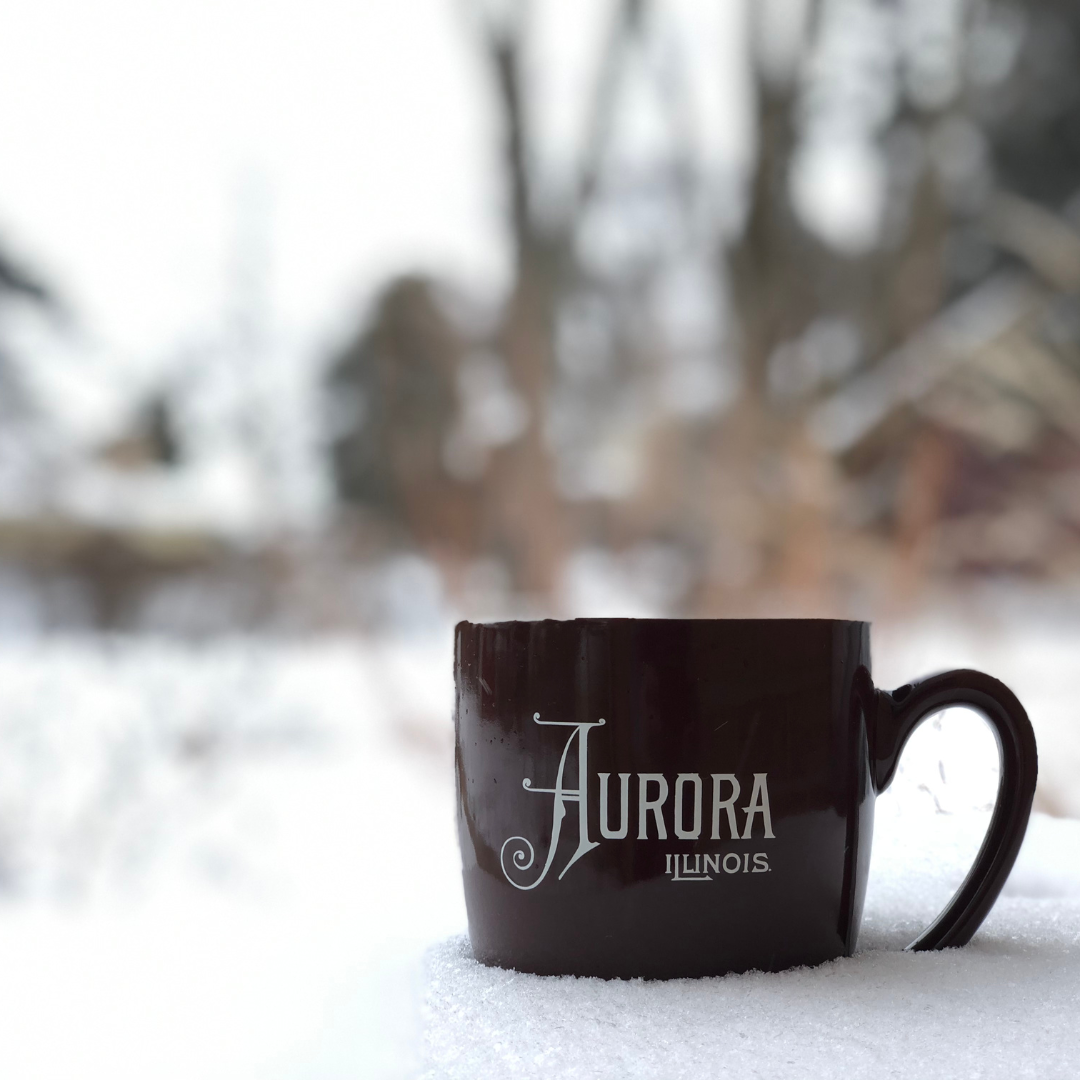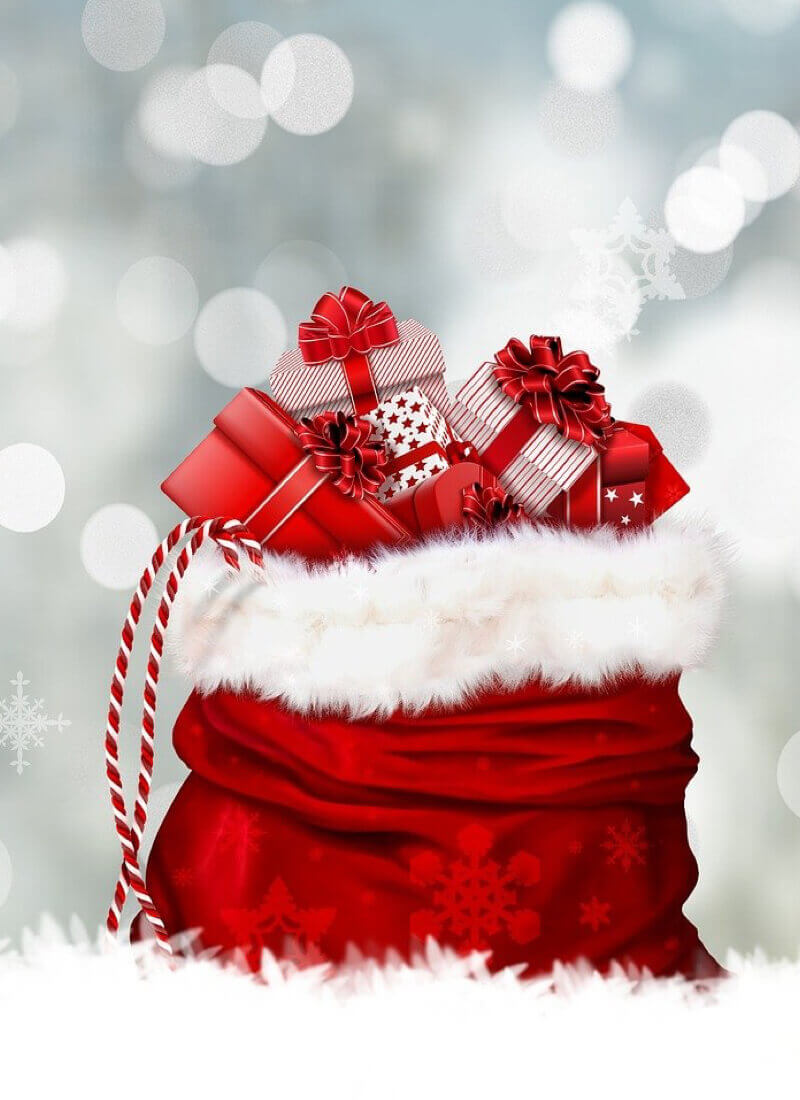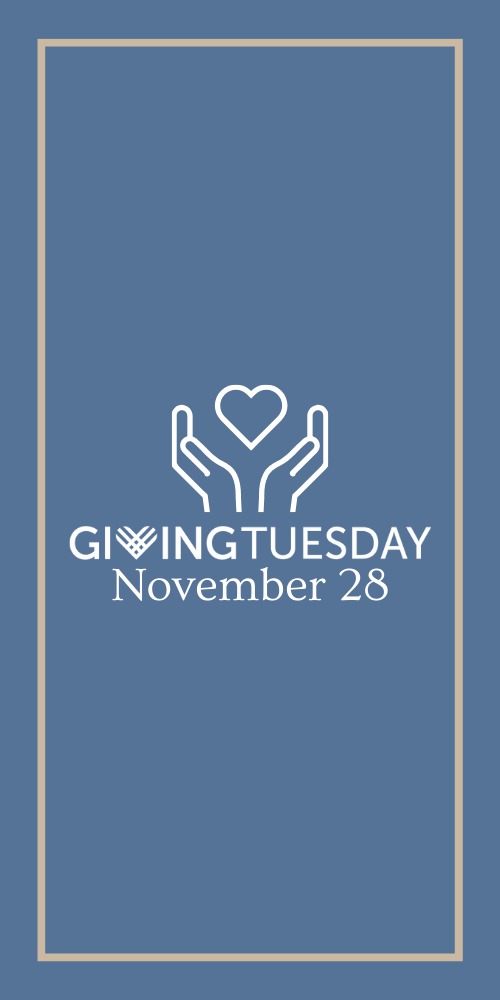This article originally appeared on Kane County Connects as a part of a series on Kane County’s amazing history.
The phrase “boys of summer” first came from the pen of the Welsh poet Dylan Thomas in 1934. It was a bittersweet lament about vanished youth. Later, sportswriter Roger Kahn used it to title his history of the legendary 1950s Brooklyn Dodgers baseball team. Then Don Henley of The Eagles turned it into a memorable, and Emmy-winning, love song.
In Aurora, we have had boys of summer since the Civil War and every year when the weather turns warm, we get a little nostalgic for the sights and sounds of baseball, or as it used to be called, base ball.
Baseball Beginnings
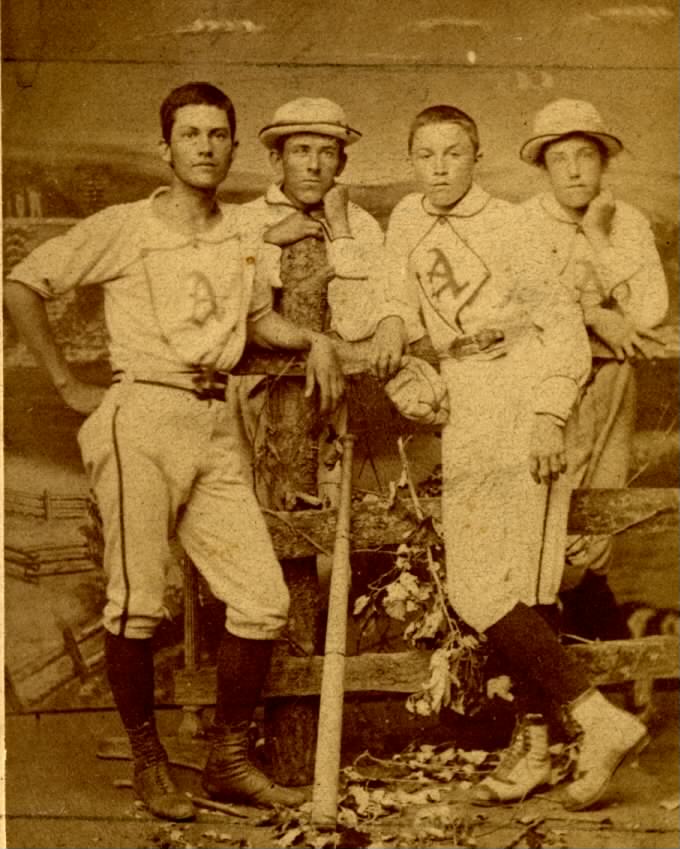
Bat-and-ball games have been around in Western civilization since at least medieval times, and European colonists in the New World no doubt brought “rounders” and cricket here in the 1600s and 1700s.
The sport morphed into “base ball,” with many regional variations. By the 1860s, young American men thrown together by the Civil War were playing the “New York” game or the “Philadelphia” game or whatever they cared to call the particular version they crafted in their various bivouacs and winter quarters.
Returning to their home towns, these early boys of summer began forming local amateur teams, a development which had social as well as athletic impact, as evidenced in this Aug. 23, 1876, comment in the Aurora Beacon:
“The base ball fever has one good effect on the appearance of our streets on Sundays, for where the corners and steps used to be crowded, there is not now a loafer to be seen. All are on the flats below town engaged in ball playing.”
One such team was Aurora’s Town Club, and more about that in a minute.
Meet Commander Nelson
But first, please meet Commander Paul Nelson (ret.) of the Aurora Police Department.
As kids growing up on Aurora’s east side, Paul and his older brother, Dan, learned the game on endless summer days playing with their dad in Solfisburg Park just behind their house.
He remembers neighborhood pickup games as the best for the freedom and self-agency they offered, even if Dan tended to make up rules on the spot to advantage himself. Paul and his friends — truly the boys of summer — were living an American dream, although maybe they didn’t know it at the time.
After East High, Paul went to Aurora University for a degree in criminal justice, served in the military, then advanced through the ranks at the Aurora Police Department. (He retired in 2017 with the rank of commander, having also served for a time as interim chief.)
There was no baseball for him then except on TV, but the lure of history, always his first love, led him to become a Revolutionary War re-enactor with a special interest in the story of the Illinois frontier and Col. George Rogers Clark’s achievements in securing the Old Northwest Territories for the U.S.
He is currently writing a book that will meld old maps and current satellite imagery to revise some traditional thinking about Clark’s 1778 Illinois campaign.
Paul Nelson’s interest in the American Revolution did not stop at geography. He has heard so many stories told about long-range rifle shots during that war that he thought a little investigation might be in order.
He conducted his own tests of the terminal ballistic capabilities of a .50 caliber round ball fired from a flintlock, shared them with the gunsmiths of Colonial Williamsburg, and will soon be publishing the results.
But getting back to baseball, by his mid-30s Nelson was starting to think about playing the game again.
“I often regretted that when I had opportunities to play as a kid I actually played so little and quit so soon,” he said. “I used to think (about being) able to play just one more full nine-inning, nine-on-nine baseball game.’”
It was his wife, Doreen, who first spoke the words Vintage Base Ball to him.
They were on vacation, visiting Greenfield Village, the open-air history museum near Detroit, when she picked up a flyer about a game to be played that day by the museum’s team, the Lah-De-Dahs.
Would he be interested, she wondered? “I don’t know,” was his response. “What’s Vintage Base Ball?” But their schedule had no wiggle room, so they left the museum and that might have been all there was to the story.
However, as sometimes happen, once you hear about something “new,” you find that it’s been all around you all the time. Over the next decade, Nelson kept hearing about vintage base ball and thought maybe that would be something to do in retirement.
In 2010, he saw an advertisement for a match right here in Aurora, pitting the Somonauk Blue Stockings against the Oregon Ganymedes. Nelson went to Blackberry Farm, bought himself some popcorn and a lemonade, set his chair under a shady tree, and on a beautiful summer day in Aurora fell in love.
How do these things happen? Was it the sound of a wooden bat on a ball? Was it the peculiarity of the foul lines or base running? Something about the things the arbiter (umpire) would say?
Perhaps it was the uniforms. As a man who spent a lot of time in uniforms, modern police or Revolutionary War, Nelson had a keen eye for function and design.
Or maybe it was a sharp kick in memory’s rib from the kid who didn’t play when he could and grew up to regret it.
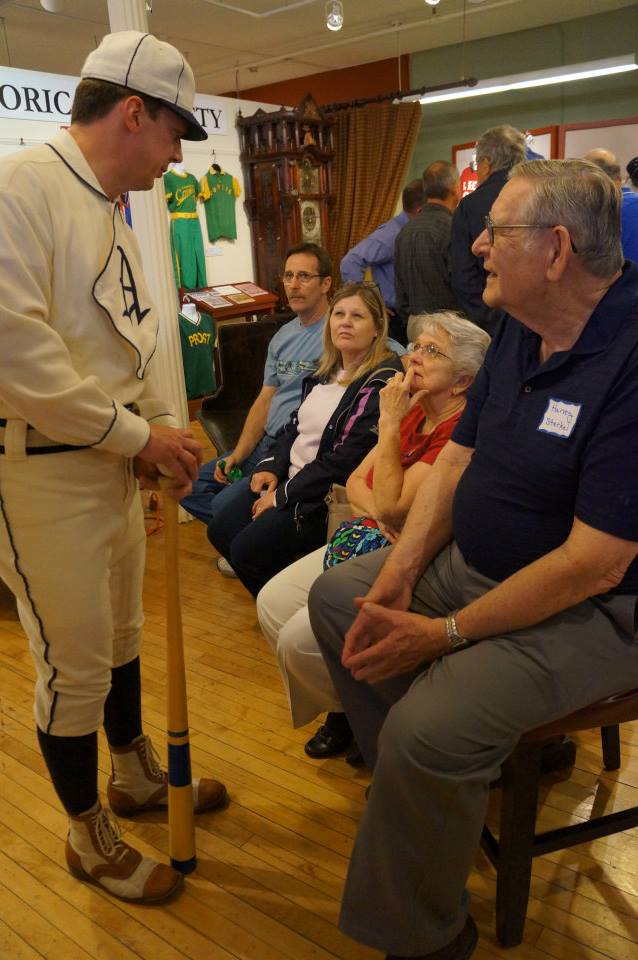
Here is Nelson telling the story:
Sitting there watching the match was like being transported back in time, and then a B-2 Spirit bomber flew over very low on its turn-around from an air show in Rockford and spoiled the time warp. How ironic! The first time I ever saw the stealth bomber live was at a Vintage Base Ball match.
I wanted to start playing baseball again, and after seeing the Blackberry Farm match, I immediately knew that this was going to be the vehicle for that. I was so hoping that they would ask for a volunteer from the crowd to play an inning or two. (They didn’t.)
I knew as I watched that I had to play immediately, and the only thing to be resolved was how that was going to happen.
After the match, Nelson approached the managers for both teams. He wanted to know if either would take on a new player.
Nelson again:
I spoke with both managers after the match and inquired about joining either of their teams. Both welcomed it, but the manager of the Blue Stockings, Mike “Ace” Adrian had another idea.
He had long-standing business connections in Aurora and knew our history well. When he learned I was from Aurora, he said, “You’re welcome to join our team, but with the rich baseball and fastpitch softball history Aurora has, I’m surprised no one has ever started a team here. Why don’t you?”
I was also surprised to learn that there was a league based right here in northern Illinois with plenty of competition in the area. I thought about Ace’s comments on the way home, and upon arriving home I told Doreen, “Change of plans. I can’t wait until I retire — I have to play now!”
Recruiting a Team
Nelson felt confident that, given the strong baseball subculture at the Aurora Police Department, he could find enough men to form a vintage base ball team, and he was right.
His first recruits were from a group of APD White Sox fans who together made an annual trip to Opening Day at Comiskey Park. That wasn’t enough for a full team, however, so Nelson added a couple of Cubs fans.
He says he never intended it to be a police team, and the Police Department did not sponsor it. Those were just the people he knew and worked with.
“It could have been an insurance company team,” he says.
Entering a League
There were no formalities or niceties to consider in getting into vintage base ball — it was “Play ball!” from day one.
Ace Adrian sent Nelson a copy of the 1858 rules the Northern Illinois Vintage Base Ball League plays by and the police team’s first practice was the last Saturday of August 2011.
Nelson says, “Then with six practices under our belts and with no one on our team except me having even seen a VBB match, we ventured out to Somonauk in T-shirts and sweatpants to play Ace’s Blue Stockings, and we beat them in 10 innings.”
Naming And Outfitting
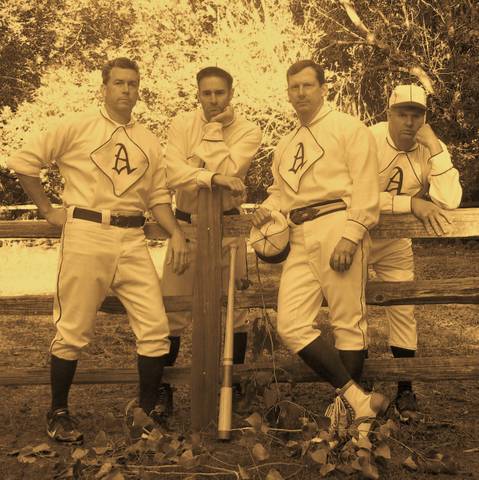
With their one-game inaugural season behind them, the next steps were to name the team and get uniforms.
Here is Nelson again:
I wanted to re-create a team from the pages of Aurora’s history, so I called the Aurora Historical Society to see what they had. Going backwards in time in the baseball archive, I tried to find Aurora’s earliest team.
I found one team, from the 1890s I think, called the Aurora Moderns, and I was hoping that wasn’t the oldest, because I didn’t want to form a Vintage Base Ball team called the Moderns. They also played in navy blue wool uniforms, which wouldn’t have been enjoyable in the summer.
As an Aurora police officer, I had spent many summers wearing navy blue polyester. The only thing I could think of that would be more uncomfortable was navy blue wool.
Then I came across a Beacon News article from July 4, 1886, in which they covered a 4th of July match between the “Aurora Town Club” and a team from Naperville. That was the earliest name I came across for an Aurora team, but I wasn’t crazy about the uniform that was in the picture.
Additionally, it was two decades past the target date I was hoping for (the Northern Illinois Vintage Base Ball League plays according to the original 1858 consolidated rules).
So I kept going backwards, and then I finally came across a sepia photo of four young men/boys posing in a studio against a wooden fence prop, wearing exactly the type of uniform I wanted to wear.
On the back of the photo was written, “Baseball players from the 1870s”. No name was given for the team, but I loved the uniform, except for the dumbest-looking hat I had ever seen for a baseball uniform.
I wanted to replicate that uniform, but not the hat, and then I noticed that one of the two players in the front was holding what was clearly a six-panel, short brim ball cap. And that was how I came up with our uniform and name.
I took the earliest photo of an Aurora team I could find, worked with a VBB custom uniform maker to develop a pattern to replicate it, had an historical baseball cap maker custom-make the six-panel caps for us, and since the 1870s photo had no team name associated with it, I used the name “Aurora Town Club” from the 1886 Beacon News article.
Paul Nelson is nothing if not thorough, and once he had the basic team uniform figured out, he used his re-enactor experience to create the fine details of his personal uniform.
He explains:
We got our first set of 1858 balls from K&P Weaver in Connecticut, and our vintage-style bats from Phoenix Bats.
And then for me on a personal level, I wanted to go the extra step to playing in a completely authentic uniform, so I got knit blue wool stockings and leather garters to hold them up from one of my Rev. War suppliers.
My research indicated that the belts and shoes worn in the original 1870s photo likely came from Snyder’s 1875 Sporting Goods catalog, so I had my Rev. War supplier hand-weave a length of worsted wool fabric that I finished into a replica of Snyder’s base ball belt, and I had a historic shoe & boot maker in Wyoming custom-make a pair of reproduction base ball shoes based on examples from Snyder’s, as well as the 1889 Spaulding’s catalog.
Next Up, Finding A Place To Play
There was one more thing to work out, Nelson remembers — “a place to play our home matches.”
I drove around town looking for large, open grass fields with few or no obstructions. I initially settled on the open field belonging to IMSA behind Randall Park, and they were kind enough to allow us to play our first couple of seasons there.
Later we moved to Simmons Park, and after the FVPD changed their field use requirements, we finally ended up in the field behind Resurrection Evangelical Lutheran Church for our last few seasons. That was all for the prep work.
Culture
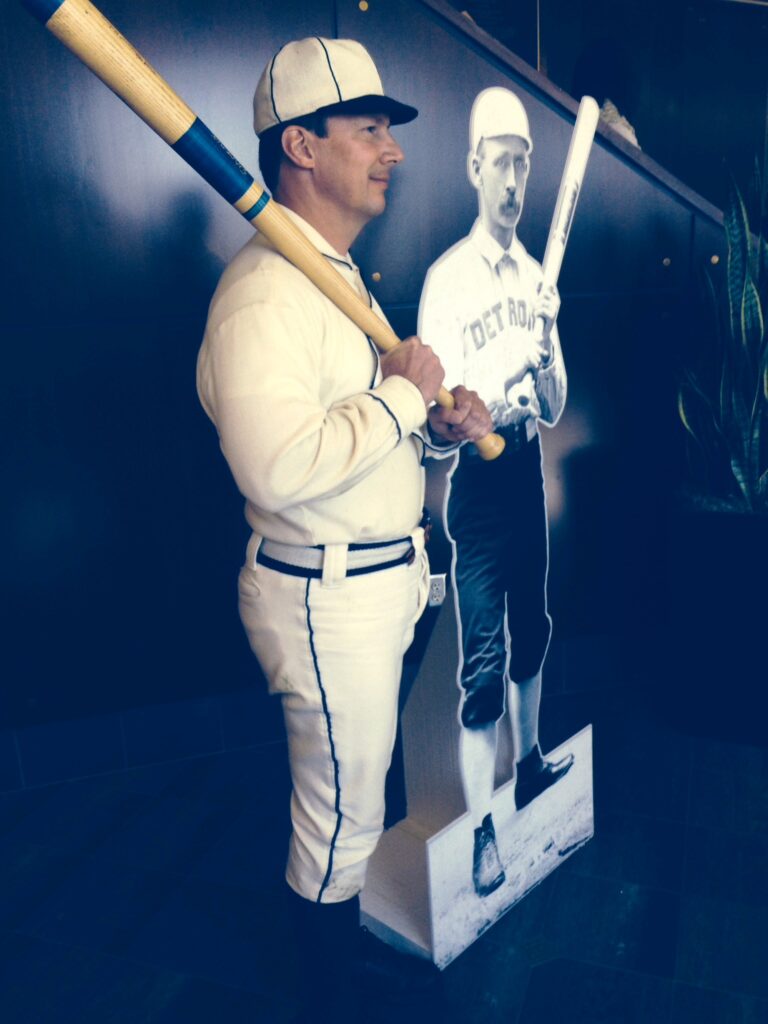
Not only the clothing harked back to another period. Vintage base ball is very much a gentleman’s game: swearing, tempers, bad behavior, and bad sportsmanship are singled out as no-gos.
Nicknames are another aspect of the culture. Nelson decided on Slugger. He says he wasn’t trying to portray himself as a heavy hitter, but rather was offering tribute to his dad Don, a banker, who passed away in 1997.
“Today I love to hear someone call out ‘Slugger!’ in a game, because it makes me think of my father,” he says. “When Dad died my brother and I debated whether or not to put ‘Slugger’ on his tombstone until Dan pointed out that a lot of people probably never knew his real name. He said if we don’t put Slugger on there people might not know who it is. That settled the question.”
The Rise Ball And The Drop
The Aurora Town Club, in its 21st century embodiment, quickly became a force in the vintage base ball universe.
Perhaps it was the athletic advantage that SWAT police officers would bring to any playing field. Perhaps it was the practice-practice-practice discipline of the group.
Or perhaps it was the post-game investigations into every loss to figure out exactly how the other team managed to outscore them. These boys of summer liked to win.
Whatever the secret, the team, over 10 years, compiled a record of 37 wins and 17 losses, for a winning percentage of .685, better than the top Major League teams can offer these days. In their last five years their record was 20-5, a stratospheric winning percentage of .800.
Then came changes in the personal lives of the team members, thinning their ranks, and then came COVID-19. In 2020, the group decided to disband, going out on top, as it were and leaving the sporting history of Aurora with a gem, a soul-satisfying tour of the bases from the 19th century boys of summer all the way around to the boys of summer today.
Would Cmdr. Paul Nelson, Ret., want to play again? Actually, no or perhaps sort of. Time, he feels, has take a toll on his abilities. He has had rotator cuff and hamstring injuries and, well, you know.
Time takes a toll. Summer never lasts.
Today he would consider coaching or managing a vintage base ball team, sharing what he learned so others could have the pleasure of America’s pastime in their ungloved hands as they tip their hats to their opponents, gentlemen all.
You can read many of Paul Nelson’s reports on the Town Club modern history and individual games on the Facebook page, Aurora Town Club Vintage Base Ball.

